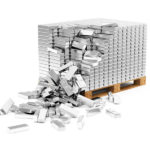India Silver Imports Surged by 90% Last Year
(January 10, 2018 - by Metals Focus)
Will the market see a repeat in 2018?
Last year, Indian silver bullion imports jumped by 90% to an estimated 5,750t. Although this performance was flattered by an exceptionally weak 2016, last year’s total was still the third highest this decade. However, during this time, Indian imports have been notoriously volatile, with an average year-on-year change between 2011-17 of around +40%. Even though another surge in imports in 2018 may appear unlikely, given the extent of last year’s rise, we should still see these shipments rise over the next 12 months.
To help understand how the Indian silver market may develop in 2018 it is worth revisiting some recent key developments. One of the most striking trends in the Indian market this decade was the dramatic rise in imports, from just 1,942t in 2012 to a record high of 7,570t in 2015. This was driven by a huge rise in physical investment, which rose by 1,750t over these three years, followed by jewelry fabrication, which grew by 1,050t. Silverware offtake also improved, albeit by a more modest 600t, while industrial demand actually slipped by 260t between 2012 and 2015.
Focusing on physical investment, much of the above-mentioned increase was driven by bar demand (as opposed to coins). This reflected two themes, the trend in rupee silver prices and silver’s role as a vehicle for unaccounted money (especially following the clampdown on gold). In terms of the former, after peaking at almost Rs.70,000/kg in early 2011, local prices weakened, but also remained quite volatile.
This encouraged bargain hunting among investors who believed that silver was increasingly undervalued. This buying was further supported by the spread between spot and futures prices, which allowed for arbitrage trading. With regards to the second driver, given its low price point, ownership of silver bars has for many years been a popular home for unaccounted money. More recently, the government’s ongoing crackdown on cash transactions (and its drive for greater transparency across the economy) led to a ramp-up of unaccounted flows into the silver market.
However, in 2016 as rupee silver prices broadly stabilized, the far more subdued trading pattern discouraged investors from further buying into silver. There was also an element of market saturation, which limited fresh inflows of investor bargain hunting. More important though was the impact of the Indian government’s drive against the shadow economy, which culminated in the late-2016 demonetization. As a result, flows of undeclared money into silver dried up, a situation which also continued last year. Furthermore, as the Indian authorities continue with their anti-money laundering drive, there seems little prospect in the future of silver acting as a vehicle for undocumented money.
In spite of the weak investment trend in 2017, bullion imports still enjoyed a strong recovery last year, thanks to improved jewelry and silverware fabrication. Both segments benefited from an improving Indian economy and the impact of broadly stable local prices. An added driver for jewelry was the jump in finished exports. Available data for January to October points to a 39% y/y rise in the value of jewelry exports, led by Hong Kong, the UAE and the US. Aside from the improvement in demand the rise in bullion imports was fuelled by trade restocking as lower imports in 2016 saw inventories depleted. There was also some buying by the supply chain ahead of the introduction (last July) of the Goods and Services tax.
In terms of this year, even though we expect silver prices to strengthen (as discussed in last week’s release of our latest One-Year Forecast), this should be offset by the positive impact stemming from a still relatively healthy Indian economy. However, we have to allow for the prospect that jewelry exports fail to grow and so remain close to 2017’s strong performance. This follows strong gains in the previous three years (overseas shipments rose from $983m in 2013 to $3.3bn in 2016) which, going forward, may limit the potential for a further rise in Indian silver jewelry exports.
Overall therefore, following an estimated 7% rise in total Indian demand last year, we are forecasting just a 3% lift in 2018. As a result, Indian imports should improve further this year, albeit modestly.






